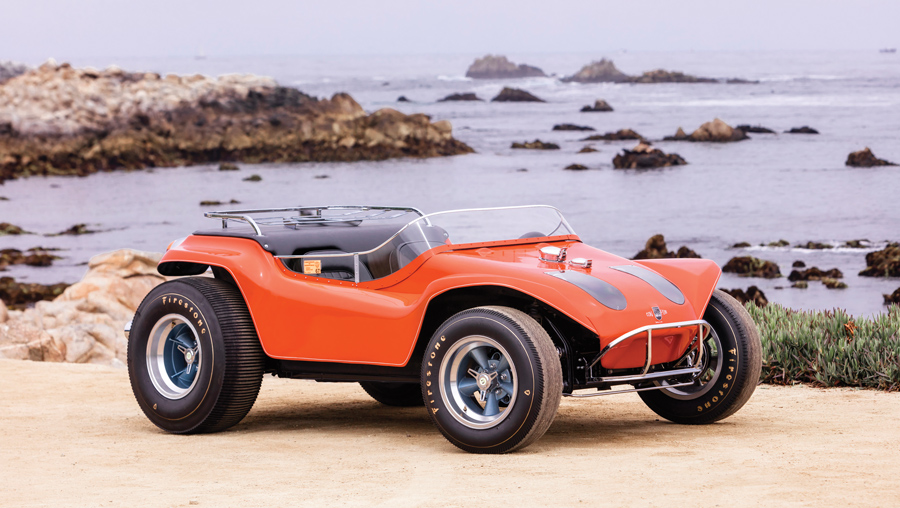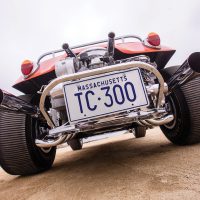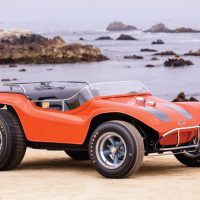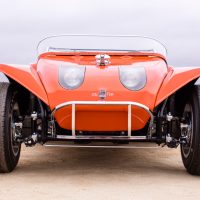SCM Analysis
Detailing
| Vehicle: | 1967–68 Con-Ferr Meyers Manx |
| Years Produced: | 1964–71 |
| Number Produced: | About 6,000 |
| Original List Price: | $985 |
| SCM Valuation: | $25,000 |
| Tune Up Cost: | $50 |
| Distributor Caps: | $10 |
| Chassis Number Location: | Under the rear seat |
| Engine Number Location: | Below the generator |
| Club Info: | Manx Club |
| Website: | http://www.manxclub.com |
| Alternatives: | Kellison Sandpiper, EMPI Imp, Meyers Tow’d |
| Investment Grade: | C |
This car, Lot 119, sold for $456,000, including buyer’s premium, at Bonhams’ Amelia Island, FL, auction on March 5, 2020.
The traditional dune buggy has enjoyed renewed popularity in recent years, and there are certainly plenty of them out there. Bruce Meyers’ inspired design smashed the orthodoxy of off-road racing and spawned a host of copycats. The audacious dune buggy even got its own anthropomorphic after-school animated TV show, and pop stars such as the Monkees routinely appeared in them. Even Elvis made an appearance or two.
The Meyers Manx
Southern California has always been a breeding ground for custom vehicles, and during the early 1960s, Bruce Meyers was in the heart of that culture. Fiberglass was the material of the day, and companies such as Kellison and Cheetah were producing rebuild kits that were unlike anything going. In that environment, Meyers imagined a new vehicle for beach and desert use, based on hardy and readily available Volkswagen underpinnings. Meyers’ first prototype, finished in 1964, is known as Old Red, and most dune buggies look like that prototype to this day.
The idea is fairly simple. Take the floorpan from a VW Beetle and cut 14 inches out of the middle, then weld it back together to make a short-wheelbase platform. Drop a new fiberglass roadster body on it with wildly flared wheelarches. Leave the rear end open to show off the engine and put a simple clamshell nose on it. Perhaps bolt on a windshield to satisfy the DMV.
Underneath, it’s all VW, from the torsion-bar-beam front suspension to the swing-arm rear axles and the VW drivetrain. The finished package doesn’t weigh much, so even a stock 40-horsepower engine gives you fun performance. Meyers immediately began breaking desert racing records in his creation.
Meyers produced 12 kits to build the Manx in 1964 and 1965. He then began regular series production. From 1965 to 1971, about 6,000 of the Manx buggies were produced at B.F. Meyers & Co. The company went out of business in 1971, in large part due to the massive wave of copies.
The copycats
The best thing about fiberglass is that just about anyone can replicate a part. That’s also the worst thing about fiberglass from a business perspective. Meyers had obtained a patent on his idea, but it was ruled unenforceable when others began producing similar designs.
Even sports-car maker Kellison got into the act, and actually sold more buggies than Meyers’ company. EMPI, the aftermarket provider of air-cooled VW parts, also got into the buggy business. Over the years, hundreds of upstart companies riffed on Meyers’ design without paying a penny in royalties. The result is that there are tens of thousands of dune buggies out there in various states of originality and restoration, but only a few thousand are Manx originals.
Collecting a Manx
Today, collectible buggies come in two types: authentic classic Manx and everything else. You can pick up a good-condition buggy for less than $5,000 and enjoy driving it. Retailers are still selling new Manx-style bodies, and Meyers himself is back in business with Meyers Manx Inc. (www.meyersmanx.com), selling new bodies and parts.
For decades, Californians have been walking by buggies that were left to fill up with rainwater. Now they’re all being cleaned up and offered for sale. Act quickly, though, because prices have been rising across the board.
If you are considering a buggy, the first thing to do is check to see if it’s a real Manx. Many uninformed buggy owners assume incorrectly that their vehicle is a Manx. There are websites with detailed information on how to tell a real Meyers Manx from a copycat.
Next, have the floorpan closely inspected. If the buggy is a short-wheelbase variety, that pan had to be cut and re-welded. Check those welds and the entire chassis for rust. Then look for the usual indicators of quality in the driveline and running gear. The good news is that every piece is available and easy to replace.
One note to remember: Some classic-car insurers will insure a dune buggy only if it’s a verified Meyers Manx. Others are less selective.
The McQueen Effect strikes again
Right now, a tour through SCM’s Platinum Auction Database shows that a good-quality original Meyers Manx can command up to $45,000 at auction (SCM# 6915834). Some have sold for more, while most have sold for less — even under $10,000 — during the past year.
With that in mind, it’s obvious that our subject sale can’t even be evaluated in the same class as those buggies.
The profile subject car is the one that Steve McQueen drove around in “The Thomas Crown Affair,” with Faye Dunaway riding in the passenger’s seat. Look up the scene — it’s on YouTube. McQueen himself helped spec out this highly customized buggy, with a 6-cylinder Corvair engine and comfortable quilted interior. If the car was in original condition, like the much-ballyhooed “Bullitt” Mustang, it might have brought even more money. However, this buggy had been living in Hawaii, where it had been used hard, repainted, and ultimately left to rot like so many others. The seller invested quite a lot of money to put it back into as-filmed condition before the sale. The auction listing states the VW floor pan had been replaced at least once.
But even in restored condition, this was McQueen’s car, and that apparently multiplies the value tenfold. Fair enough, but it would be more apt to compare this car to the “Bullitt” Mustang, which pulled $3.74 million in January. Against that sale, this buggy looks like a bargain. ♦



